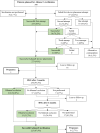Procedural and clinical outcomes of Adiana® hysteroscopic tubal occlusion in the Netherlands
- PMID: 39718327
- PMCID: PMC11819784
- DOI: 10.52054/FVVO.16.4.050
Procedural and clinical outcomes of Adiana® hysteroscopic tubal occlusion in the Netherlands
Abstract
Background: The Adiana® Permanent Contraception System was a hysteroscopic tubal occlusion device but was withdrawn from the market in 2012.
Objective: To evaluate the safety, feasibility and efficacy of the Adiana hysteroscopic tubal occlusion.
Materials and methods: A prospective observational multicentre cohort study of 300 women undergoing hysteroscopic sterilisation using the Adiana® was conducted in the Netherlands between 2009 and 2012. All procedures were performed using the same study protocol. Three months after bilateral placement a hysterosalpingography (HSG) was performed to confirm tubal occlusion. In 2018-2020 follow-up questionnaires were sent to all women.
Main outcome measures: The primary outcome was the success rate of the Adiana tubal occlusion technique. Successful tubal occlusion was defined as an uneventful procedure with occluded fallopian tubes according to the HSG after 3 months. Secondary outcomes were the success rate of the device placement, the number of complications during placement and the pregnancy rate.
Results: Bilateral placement of Adiana devices was achieved in 93.5% of cases. Bilateral confirmed occlusion by HSG was accomplished in 87.9% of cases with successful Adiana placement. This was 77.1% in the intention-to-treat group. Complications and side effects were reported in 4.4% of women. The pregnancy rate was 3.6% in women with proven bilateral tubal occlusion.
Conclusion: Hysteroscopic tubal occlusion using the Adiana technology is associated with a pregnancy rate of 3.6%. Although this technology was removed from the commercial market, this evaluation of the Adiana technology could provide useful information for the development of potential new, more effective hysteroscopic tubal occlusion devices.
What’s new?: Hysteroscopic tubal occlusion techniques are no longer available on the market. This evaluation of Adiana could provide useful information for the development of potential new hysteroscopic tubal occlusion devices.
Conflict of interest statement
Figures
References
-
- Anderson TL, Vancaillie TG. The Adiana System for Permanent Contraception: Safety and Efficacy at 3 Years. J Minim Invasive Gynecol. 2011;18:612–616. - PubMed
-
- Chudnoff SG, Nichols JE, Jr, Levie M. Hysteroscopic Essure Inserts for Permanent Contraception: Extended Follow-Up Results of a Phase III Multicenter International Study. JMIG. 2015;22:951–960. - PubMed
-
- Connor VF. Essure: a review six years later. J Minim Invasive Gynecol. 2009;16:282–290. - PubMed
-
- Dessole S, Meloni GB, Capobianco G, et al. A second hysterosalpingography reduces the use of selective technique for treatment of a proximal tubal obstruction. Fertil Steril. 2000;73:1037–1039. - PubMed
-
- FDA. FDA Activities Related to Essure [Online] 06 10, 2022. https://www.fda.gov/medical-devices/essure-permanent-birth-control/fda-a....
LinkOut - more resources
Full Text Sources

